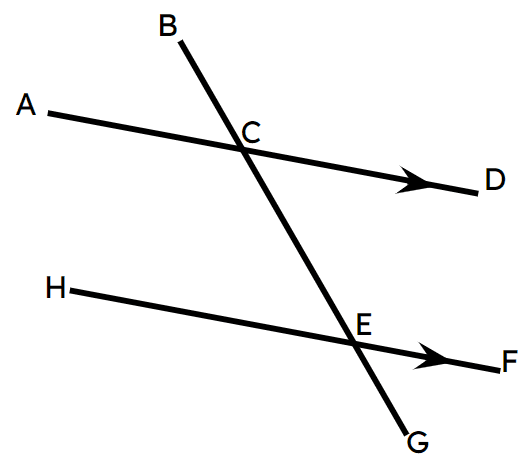Starter quiz
- In which cases are the angles always equal to each other?
- adjacent angles on a straight line
- alternate angles on parallel lines ✓
- co-interior angles on parallel lines
- corresponding angles on parallel lines ✓
- vertically opposite angles ✓
-
- Co-interior angles on parallel lines sum to ______°.
- '180' ✓
 Which angle is 97°?
Which angle is 97°?- ∠BCD ✓
- ∠CBD
- ∠CDB
- ∠DBC
-
- Match each shape with the sum of its interior angles.
- decagon⇔1440° ✓
- heptagon⇔900° ✓
- hexagon⇔720° ✓
- nonagon⇔1260° ✓
- octagon⇔1080° ✓
- pentagon⇔540° ✓
 ∠ACE = ∠FEC because ______.
∠ACE = ∠FEC because ______.- they are alternate angles on the parallel lines ✓
- they are corresponding angles on the parallel lines
- they are vertically opposite angles
-
 Which angle is co-interior to ∠ACE?
Which angle is co-interior to ∠ACE?- ∠BCA
- ∠CEH ✓
- ∠ECD
- ∠FEC
- ∠GEH
-
Exit quiz
 ∠ABG = 112°. Based on this information, which justification could be used to explain why ∠CBG = 68°?
∠ABG = 112°. Based on this information, which justification could be used to explain why ∠CBG = 68°?- Adjacent angles on a straight line sum to 180°. ✓
- Angles in a triangle sum to 180°.
- Co-interior in parallel lines angles sum to sum to 180°.
-
 Which justification could be used to explain why ∠CGF = ∠GCD?
Which justification could be used to explain why ∠CGF = ∠GCD?- Alternate angles in parallel lines are equal. ✓
- Corresponding angles in parallel lines are equal.
- Vertically opposite angles are equal.
-
 Match each statement with its justification.
Match each statement with its justification.- ∠ECD = ∠CEH⇔alternate angles in parallel lines are equal ✓
- ∠DCB = ∠FEC⇔corresponding angles in parallel lines are equal ✓
- ∠ACE = ∠DCB⇔vertically opposite angles are equal ✓
- ∠BCA and ∠ACE sum to 180°⇔adjacent angles on a straight line sum to 180° ✓
- ∠ECD and ∠FEC sum to 180°⇔co-interior angles in parallel lines sum to sum to 180° ✓
 Given ∠EGC = 82°, then ∠CGB = ______°.
Given ∠EGC = 82°, then ∠CGB = ______°.- '16' ✓
 The pentagon in the image is regular. The size of the shaded angle is ______°.
The pentagon in the image is regular. The size of the shaded angle is ______°.- '36' ✓
 The image shows a regular pentagon and a regular hexagon. The size of the shaded angle is ______°.
The image shows a regular pentagon and a regular hexagon. The size of the shaded angle is ______°.- '48' ✓
Worksheet
Presentation
Video
Lesson Details
Key learning points
- Missing angles can be found using parallel lines.
- Missing angles can be found using facts about triangles.
- Missing angles can be found in polygons using knowledge of exterior and interior angles.
- The relationship between interior and exterior angles can be used to find missing angles.
- Missing angles can be found by using a combination of all known facts.
Common misconception
Pupils may work out missing angles without writing out their justifications.
Each time a number which is not on the original diagram is used or found, an explanation should be given for where it has come from.
Keywords
Corresponding angles - A pair of angles at different vertices on the same side of a transversal in equivalent positions.
Alternate angles - A pair of angles both between or both outside two line segments that are on opposite sides of the transversal that cuts them.
Co-interior angles - Co-interior angles are on the same side of the transversal line and in between the two other lines.
Interior angles - An interior angle is an angle formed inside a polygon by two of its edges.
Exterior angle - An exterior angle is an angle on the outside of a polygon between an extension of an edge and its adjacent edge.